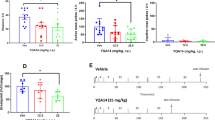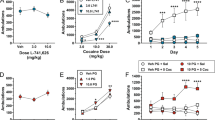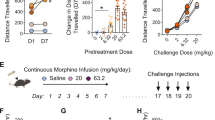Abstract
Rationale
Chronic administration of morphine induces adaptations in neurotransmission system such as the dopamine pathway, and these modifications could be influenced by the drug administration pattern. Methadone and buprenorphine are the two main opioid substitution therapies, and despite their protracted use in humans, no study has investigated their ability to regulate dopamine system after chronic exposure/withdrawal.
Objectives
We evaluated the consequences of two administration patterns of methadone and buprenorphine on striatal dopamine D1 (D1R) and D2 (D2R) receptor levels.
Methods
Mice were treated with escalating doses of methadone or buprenorphine for 5 days either once daily (binge) or three times a day (TTD). D1R and D2R density in striatum was measured by autoradiography using [3H]-SCH23390 and [3H]-raclopride, respectively, at 1 (WD1), 14 (WD14), and 35 (WD35) days after the last opioid injection.
Results
A downregulation of D1R was observed upon TTD administration of buprenorphine and binge methadone treatment while an increase of those receptor levels was detected both with binge buprenorphine and TTD methadone treatments. Concerning the D2R, we rather measured an early or late downregulation with both agonists and administration patterns.
Conclusions
Our results demonstrated that methadone and buprenorphine were able to differentially regulate dopamine receptor density depending on the withdrawal period and the administration pattern.




Similar content being viewed by others
References
Allouche S, Le Marec T, Noble F et al (2013) Different patterns of administration modulate propensity of methadone and buprenorphine to promote locomotor sensitization in mice. Prog Neuropsychopharmacol Biol Psychiatry 40:286–291
Arden JR, Segredo V, Wang Z et al (1995) Phosphorylation and agonist-specific intracellular trafficking of an epitope-tagged mu-opioid receptor expressed in HEK 293 cells. J Neurochem 65:1636–1645
Baik JH (2013) Dopamine signaling in reward-related behaviors. Front Neural Circ 7:152
Beaulieu JM, Gainetdinov RR (2011) The physiology, signaling, and pharmacology of dopamine receptors. Pharmacol Rev 63:182–217
Belkai E, Crete D, Courtin C et al (2013) Comparison of the transcriptional responses induced by acute morphine, methadone and buprenorphine. Eur J Pharmacol 711:10–18
Borgland SL, Connor M, Osborne PB et al (2003) Opioid agonists have different efficacy profiles for G protein activation, rapid desensitization, and endocytosis of mu-opioid receptors. J Biol Chem 278:18776–18784
Bossert JM, Poles GC, Wihbey KA et al (2007) Differential effects of blockade of dopamine D1-family receptors in nucleus accumbens core or shell on reinstatement of heroin seeking induced by contextual and discrete cues. J Neurosci 27:12655–12663
Charpak G, Dominik W, Zaganidis N (1989) Optical imaging of the spatial distribution of beta-particles emerging from surfaces. Proc Natl Acad Sci U S A 86:1741–1745
Di Chiara G (1999) Drug addiction as dopamine-dependent associative learning disorder. Eur J Pharmacol 375:13–30
Durieux PF, Schiffmann SN, de Kerchove D et al (2012) Differential regulation of motor control and response to dopaminergic drugs by D1R and D2R neurons in distinct dorsal striatum subregions. EMBO J 31:640–653
Finn AK, Whistler JL (2001) Endocytosis of the mu opioid receptor reduces tolerance and a cellular hallmark of opiate withdrawal. Neuron 32:829–839
Franklin KBJ, Paxinos G (1997) The mouse brain in stereotaxic coordinates. Academic, San Diego
Gerra G, Maremmani I, Capovani B et al (2009) Long-acting opioid-agonists in the treatment of heroin addiction: why should we call them substitution? Subst Use Misuse 44:663–671
Hou H, Tian M, Zhang H (2012) Positron emission tomography molecular imaging of dopaminergic system in drug addiction. Anat Rec (Hoboken) 295:722–733
Huang P, Kehner GB, Cowan A et al (2001) Comparison of pharmacological activities of buprenorphine and norbuprenorphine: norbuprenorphine is a potent opioid agonist. J Pharmacol Exp Ther 297:688–695
Jeziorski M, White FJ (1995) Dopamine receptor antagonists prevent expression, but not development, of morphine sensitization. Eur J Pharmacol 275:235–244
Keith DE, Murray SR, Zaki PA et al (1996) Morphine activates opioid receptors without causing their rapid internalization. J Biol Chem 271:19021–19024
Le Marec T, Marie-Claire C, Noble F et al (2011) Chronic and intermittent morphine treatment differently regulates opioid and dopamine systems: a role in locomotor sensitization. Psychopharmacology (Berl) 216:297–303
Ling GS, Umans JG, Inturrisi CE (1981) Methadone: radioimmunoassay and pharmacokinetics in the rat. J Pharmacol Exp Ther 217:147–151
Ling W, Casadonte P, Bigelow G et al (2010) Buprenorphine implants for treatment of opioid dependence: a randomized controlled trial. JAMA 304:1576–1583
Lutfy K, Cowan A (2004) Buprenorphine: a unique drug with complex pharmacology. Curr Neuropharmacol 2:395–402
Mattick RP, Breen C, Kimber J, Davoli M (2014) Buprenorphine maintenance versus placebo or methadone maintenance for opioid dependence. Cochrane Database Syst Rev 2: CD002207
May T, Juilfs F, Wolffgramm J (1998) Long-lasting effects of chronic mu-opioid intake on the signal transmission via dopamine D1 receptors in the limbic forebrain of drug deprived rats. Neuropharmacology 37:997–1006
McPherson J, Rivero G, Baptist M et al (2010) Mu-opioid receptors: correlation of agonist efficacy for signalling with ability to activate internalization. Mol Pharmacol 78:756–766
Nestby P, Schotte A, Janssen PF et al (1997) Striatal dopamine receptors in rats displaying long-term behavioural sensitization to morphine. Synapse 27:262–265
Pradhan AA, Smith ML, Kieffer BL et al (2012) Ligand-directed signalling within the opioid receptor family. Br J Pharmacol 167:960–969
Raynor K, Kong H, Chen Y et al (1994) Pharmacological characterization of the cloned kappa-, delta-, and mu-opioid receptors. Mol Pharmacol 45:330–334
Rosenthal RN, Ling W, Casadonte P et al (2013) Buprenorphine implants for treatment of opioid dependence: randomized comparison to placebo and sublingual buprenorphine/naloxone. Addiction 108:2141–2149
Rothwell PE, Gewirtz JC, Thomas MJ (2010) Episodic withdrawal promotes psychomotor sensitization to morphine. Neuropsychopharmacology 35:2579–2589
Saidak Z, Blake-Palmer K, Hay DL et al (2006) Differential activation of G-proteins by mu-opioid receptor agonists. Br J Pharmacol 147:671–680
Selley DE, Sim LJ, Xiao R et al (1997) Mu-opioid receptor-stimulated guanosine-5′-O-(gamma-thio)-triphosphate binding in rat thalamus and cultured cell lines: signal transduction mechanisms underlying agonist efficacy. Mol Pharmacol 51:87–96
Serrano A, Aguilar MA, Manzanedo C et al (2002) Effects of DA D1 and D2 antagonists on the sensitisation to the motor effects of morphine in mice. Prog Neuropsychopharmacol Biol Psychiatry 26:1263–1271
Shaham Y, Stewart J (1996) Effects of opioid and dopamine receptor antagonists on relapse induced by stress and re-exposure to heroin in rats. Psychopharmacology (Berl) 125:385–391
Tien LT, Park Y, Fan LW et al (2003) Increased dopamine D2 receptor binding and enhanced apomorphine-induced locomotor activity in mu-opioid receptor knockout mice. Brain Res Bull 61:109–115
Ting AKR, van der Kooy D (2012) The neurobiology of opiate motivation. Cold Spring Harb Perspect Med 2
Vanderschuren LJ, Tjon GH, Nestby P et al (1997) Morphine-induced long-term sensitization to the locomotor effects of morphine and amphetamine depends on the temporal pattern of the pretreatment regimen. Psychopharmacology (Berl) 131:115–122
Wheeler-Aceto H, Cowan A (1991) Buprenorphine and morphine cause antinociception by different transduction mechanisms. Eur J Pharmacol 195:411–413
Wise RA (1980) Action of drugs of abuse on brain reward systems. Pharmacol Biochem Behav 13(Suppl 1):213–223
Yassen A, Olofsen E, Dahan A et al (2005) Pharmacokinetic-pharmacodynamic modeling of the antinociceptive effect of buprenorphine and fentanyl in rats: role of receptor equilibration kinetics. J Pharmacol Exp Ther 313:1136–1149
Yoo JH, Yang EM, Cho JH et al (2006) Inhibitory effects of berberine against morphine-induced locomotor sensitization and analgesic tolerance in mice. Neuroscience 142:953–961
Yu S, Zhang X, Sun Y et al (2006) Pharmacokinetics of buprenorphine after intravenous administration in the mouse. J Am Assoc Lab Anim Sci 45:12–16
Acknowledgments
This work was supported by the foundation Bettencourt-Schueller (Prix Coup d’Elan).
Conflict of interest
The authors declare no conflict of interest.
Author information
Authors and Affiliations
Corresponding author
Electronic supplementary material
Below is the link to the electronic supplementary material.
ESM 1
(PPTX 9419 kb)
Rights and permissions
About this article
Cite this article
Allouche, S., Le Marec, T., Coquerel, A. et al. Striatal dopamine D1 and D2 receptors are differentially regulated following buprenorphine or methadone treatment. Psychopharmacology 232, 1527–1533 (2015). https://doi.org/10.1007/s00213-014-3785-x
Received:
Accepted:
Published:
Issue Date:
DOI: https://doi.org/10.1007/s00213-014-3785-x




